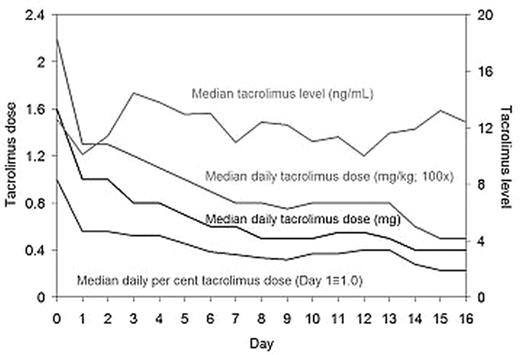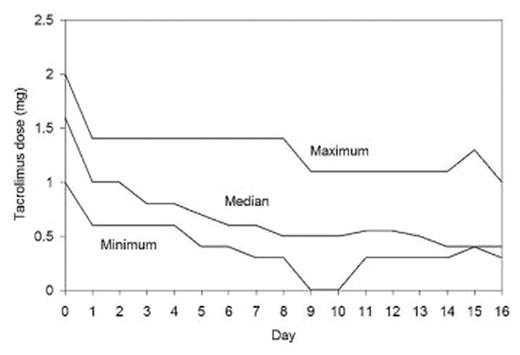Abstract
Tacrolimus is an effective immunosuppressive agent for allogeneic HSCT. It is primarily metabolized by the CYP450 3A4 isoenzyme. Voriconazole is often used to prevent fungal infections after allogeneic HSCT. It is metabolized by the CYP450 3A4, 2C9 and 2C19 isosenzymes. Studies in healthy volunteers and case reports in HSCT recipients have shown significant drug interaction between the two requiring reduction of tacrolimus dose. Ordinarily, tacrolimus prophylaxis is initiated at the dose of 0.03 mg/kg IV daily on day -1. After starting tacrolimus at this dose and having to reduce the dose substantially within 2–3 days in all patients receiving concomitant voriconazole 200 mg twice daily orally from day 0, we implemented a simple, pre-emptive tacrolimus dose reduction strategy to maintain steady-state levels between 5 and 15 ng/mL in patients on IV tacrolimus. As a first step, IV tacrolimus was initiated at the reduced dose of 0.022 mg/kg adjusted body weight per day. As a second step, tacrolimus dose was reduced by 30–40% if the steady-state level 48 h after initiation of tacrolimus (day +1) was between 7 and 10 ng/mL, and by 40–50% if the level was between 10 and 15 ng/mL. No change was made if the level was <7 ng/mL. Subsequently, tacrolimus levels were monitored 2–3 times a week and the dose adjusted as needed. In this report, we evaluate the pharmacokinetic effects of concomitant voriconazole administration on blood tacrolimus levels in 27 consecutive allogeneic HSCT recipients (28–64 years; median 55) in whom the pre-emptive dose-modification strategy was used during the first 2 weeks after HSCT while they were receiving IV tacrolimus. A total of 170 levels (3–12 per patient; median 5) were checked between day +1 and day +16. None of the levels was subtherapeutic (<5 ng/mL), and 34 (20%) were >15 ng/mL. 24 of 27 patients required dose-reduction from day 0 to day +1 based on levels. Every single patient required dose-reduction at least twice. An increase in the dose was needed in only 2 patients after initial dose-reduction. The figure below shows the minimum, maximum, and median tacrolimus doses; depicting a steady decline in the median dose.
The figure below illustrates that the median tacrolimus levels remained fairly steady as the median absolute tacrolimus dose, the median tacrolimus dose on a mg/kg basis, and the median per cent tacrolimus dose (100% being the baseline mg/kg dose) declined substantially.
It is clear from the above figure that lack of pre-emptive dose-reduction would have resulted in tacrolimus levels climbing steadily. Based on these findings, we recommend starting tacrolimus at 0.02–0.022 mg/kg rather than at 0.03 mg/kg if patients are getting concomitant voriconazole, checking levels regularly, and reducing the drug dose by 30–40% if the level is between 7 amd 10, and by 40–50% if the level is between 10 and 15.
Author notes
Disclosure:Honoraria Information: ST - Pfizer. Membership Information: ST - Speakers Bureau of Pfizer. Off Label Use: Voriconazole for prophylaxis of aspergillosis in allogeneic HSCT recipients.



This feature is available to Subscribers Only
Sign In or Create an Account Close Modal